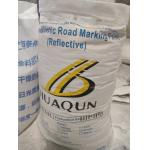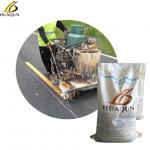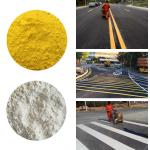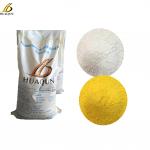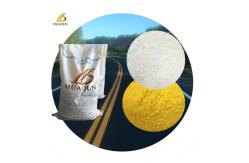Improve Road Safety with High Visibility Thermoplastic Paint
Weather Resistant and Easy Application
Product
Description
Thermoplastic paint is a type of paint that becomes soft and
moldable when heated and hardens as it cools. It's made from
thermoplastic resins, which are materials that don’t undergo a
chemical change when heated—meaning they can be reshaped or
re-melted without degrading. Key Components:- Resins (Binders) – Provide adhesion and structure.
- Pigments – Provide color and opacity.
- Glass Beads – Enhance reflectivity for visibility.
- Plasticizers – Increase flexibility and prevent cracking.
- Fillers – Adjust texture and durability.
- Solvents (Optional) – Help with application, though not typically used in
thermoplastic paint.
- Additives – Improve performance, such as UV resistance or anti-aging
properties.
Advantages of Hot Melt Paint: - Durability: Long-lasting and resistant to wear and harsh conditions.
- Quick Drying: Minimizes road downtime and allows immediate use.
- High Visibility: Reflective properties improve safety, especially at night.
- Easy Application: Fast and efficient with specialized equipment.
- Weather Resistant: Stands up to extreme weather conditions and UV exposure.
- Cost-effective: Lower maintenance and long lifespan reduce overall costs.
- Environmental Friendly: Low VOCs and minimal solvents.
- Flexibility: Adapts to surface movements and can be used for various
applications.
- Reversibility: Can be easily replaced or removed without surface damage.
- Customizable: Available in multiple colors for specific needs.
Specification | Gravity(g/㎥) | 2.1g/㎥ | | Color | Yellow, Orange, Red and etc. | | Heating Temperature | 180℃-220℃ | | Softening Point(℃) | 110℃ | | Coating Appearance | No wrinkles, dots, blisters, cracks,fall-out&stick tyres | | Drying Time(min) | Within 3 minutes | | Chroma Performance | Reverse materials(white) | | Compressive Strength(Mpa) | 26 | | Abrasive Resistance(mg) | 42 | | Alkali Resistance | Great (in saturated solution of calcium hydroxide for 24 hours | | Glass Beads(%) | 19% | | Fluidity(s) | 40s | | Coating Resistance | Resis -10℃ for 4 hours | | Package | 25kg/bag, by plastic woven bag. One 20’container can load Max 26
tons | | Heat Resistance | Under 200℃-220℃ for hours | | Material | C5 Petroleum Resin, CACO3, Wax, Glass Beads, EVA, PE and so on. | | Application | Road marking, straight line, dotted line, curve, oriented
arrow,letter and etc. | | Water Resistance | Great (in water for 24 hours) |
Applications of Thermoplastic Road Marking Paint 1. Road Markings- Lane Dividers: Used for highway lane lines, street lanes, and lanes in parking
lots.
- Pedestrian Crossings: Thermoplastic paint is ideal for pedestrian crossings because it
can withstand heavy foot and vehicle traffic.
- Traffic Symbols & Arrows: Used for marking directional arrows, stop lines, and other
traffic symbols on roads.
- Speed Bumps & Parking Areas: Thermoplastic paint is often applied in parking lots and on speed
bumps for clear demarcation.
2. Street and Highway Markings- Reflective Road Signs: Glass beads are mixed into thermoplastic paint to create
reflective road signs, improving visibility at night or in low
light conditions.
- Road Curbs and Edges: It’s used to mark road curbs or the edges of roads to guide
drivers safely.
3. Airport Runways and Taxiways- Thermoplastic paint is used for runway markings, as it is durable
enough to withstand the wear and tear from aircraft and heavy
traffic.
4. Industrial and Warehouse Markings- Floor Markings: Used in warehouses, factories, and distribution centers for
safety and organization. It helps in designating walkways, hazard
zones, and traffic routes.
- Machinery Safety Markings: Used to highlight machinery or areas where workers need to take
precautions.
5. Parking Lots and Garages- Stall Markings: Thermoplastic paint is widely used for parking lines, numbering,
and directional arrows.
- Visitor Zones: Clear demarcation for visitor parking spaces, entrances, and
exits.
6. Bicycle Lanes- Thermoplastic paint is used to create clear, visible markings for
dedicated bicycle lanes, ensuring safety for cyclists.
7. Sports Fields and Courts- Stadiums and Athletic Courts: Thermoplastic paint is used for marking the boundaries of
basketball courts, soccer fields, and other sports areas due to its
durability and resistance to wear.
8. Public Spaces and Safety Zones- Sidewalks: For demarcating crosswalks, pedestrian lanes, and other public
space markers.
- Hazard Areas: Used for safety warnings, such as marking hazardous zones or
emergency exits in public buildings.
Technical Specification
| Density(g/cm3) | 1.8-2.3 | | Softening point (℃) | 90-125 | | Compressive Strength(MPa) | ≥12 | | Glass bead content(%) | 0-30% | | Liquidity | 35±10 | | Packing | 25kg/bag | | Color | White/Yellow/Blue/Red/Green/Customized | | Executive standard | JT/T280-2004/AASHTO/BS3262/Customized | | Appearance | Powder | | Construction temperature | 180℃-220℃ | | Whiteness | 70-85(Customized) | | Inverse coefficient | 50-550 | | Warranty | 12 months | | Storage Method | Avoid light and moisture | | Packing Size | 45×70×5CM |
|
